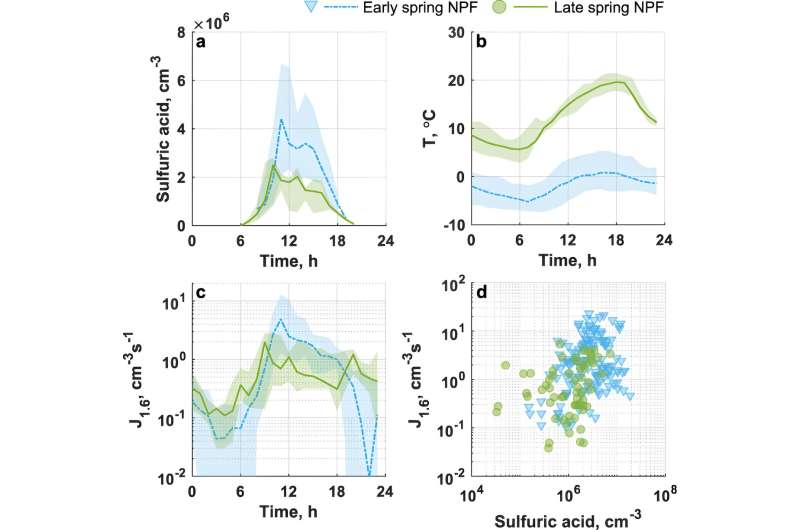This article has been reviewed according to Science X's editorial process and policies. Editors have highlighted the following attributes while ensuring the content's credibility:
fact-checked
peer-reviewed publication
trusted source
proofread
More aerosol particles than thought are forming over Siberia, finds study

Aerosol particles play a key role in cooling the planet. They can either directly affect how much sunlight ends up on the surface of the Earth or indirectly through cloud formation, to which they contribute. New particles form from a variety of gas molecules, and these particles form everywhere on the planet.
To understand the circumstances in which these particles are formed, researchers conduct measurements in various environments all over the world. For example, the Finnish flagship station SMEAR II has conducted measurements in the boreal forest for 25 years.
However, the boreal forest is an extremely large area, and much of its contribution to aerosol formation has still not been explored, especially in its Siberian and Canadian parts.
Previous studies have suggested that particle formation is rare in Siberia. However, a recent study by the University of Helsinki showed that particle formation in Siberia was frequent and was connected to heat conditions. The results of the study were published in January in the journal Environmental Research Letters.
"Our results suggest that large amounts of aerosol particles can be formed over vast areas of the West Siberian taiga in the spring, in contrast to what was previously assumed," say Olga Garmash and Ekaterina Ezhova from the Institute for Atmospheric and Earth System Research at the University of Helsinki.
The researchers also found that more aerosols form under heat wave conditions or in a warming climate, which in turn, may have a mitigating, cooling climate effect.
Heat created ideal conditions
In 2020, the researchers conducted a long-term measurement campaign using a set of state-of-the-art instruments. Their initial objective was to determine why particles rarely form in Siberia.
"Especially in March, particle formation events followed one after the other, and they were much stronger than those at the Finnish station SMEAR II," says Postdoctoral Researcher Olga Garmash.
In 2020, Siberia was under a half-year heat wave. Using multidisciplinary analysis of atmospheric chemistry, physics, and meteorology, the researchers found that forest emissions, pollution, and the heat wave had created ideal conditions for aerosol formation. The frequent new particle formation of that year was likely an exception.
"However, with warming temperatures in West Siberia, same temperatures as under the 2020 heat wave will become common in the future. This frequent new particle formation may become normal. What consequences this will have on the climate remains an important open question," says Docent and University Lecturer in Geophysics, Ekaterina Ezhova.
Aim to inform decision-making
This was the first time such comprehensive measurements with a focus on atmospheric aerosol particles were conducted in Siberia. The researchers also discovered differences in the atmospheric processes between the Siberian and Fennoscandian boreal forest.
"As the boreal forest is the largest land biome, we need more measurements in other locations to understand forest–atmosphere interactions and feedbacks in a warming climate," says Garmash.
"Our future work will benefit from collaboration with modelers: If the model reproduces observed aerosol formation, it could be used to estimate an effect of enhanced aerosol formation on clouds and precipitation. A potential application of our results is in developing and testing models, especially global Earth System Models, which are used to inform decision-making," says Ezhova.
More information: Olga Garmash et al, Heatwave reveals potential for enhanced aerosol formation in Siberian boreal forest, Environmental Research Letters (2024). DOI: 10.1088/1748-9326/ad10d5
Journal information: Environmental Research Letters
Provided by University of Helsinki




















